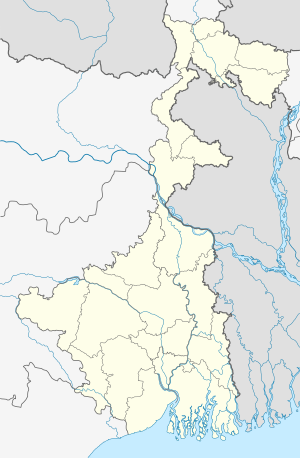Jalpaiguri Road railway station
Jalpaiguri Road railway station is one of the five railway stations which serves Jalpaiguri city in Jalpaiguri district in the Indian state of West Bengal. The other four are: Jalpaiguri City, Mohitnagar/Jalpaiguri Halt, New Jalpaiguri and Jalpaiguri Junction. The station is a newly built up junction station connecting the Barauni-Guwahati line and the New Mal-Changrabandha-New Cooch Behar line with the New Jalpaiguri-Haldibari line.
Jalpaiguri Road | |
|---|---|
| Indian Railway Junction Station | |
| Other names | Jalpaiguri Central |
| Location | Railway Road, Patkata Colony, Denguajhar, Jalpaiguri, West Bengal India |
| Coordinates | 26.5594°N 88.7097°E |
| Elevation | 84 metres (276 ft) |
| Owned by | Indian Railways |
| Operated by | Northeast Frontier Railway |
| Line(s) | Barauni-Guwahati line, New Mal-Changrabandha-New Cooch Behar line, New Jalpaiguri-Haldibari line, New Jalpaiguri-New Bongaigaon section |
| Platforms | 5 |
| Tracks | 7 |
| Construction | |
| Structure type | Standard on ground |
| Parking | Available |
| Other information | |
| Status | Functioning |
| Station code | JPE |
| Zone(s) | NFR |
| Division(s) | Katihar |
| History | |
| Opened | 1914 |
| Previous names | North Bengal State Railway |
| Location | |
 Jalpaiguri Road Location in West Bengal  Jalpaiguri Road Location in India | |
New Jalpaiguri–New Bongaigaon section | ||||||||||||||||||||||||||||||||||||||||||||||||||||||||||||||||||||||||||||||||||||||||||||||||||||||||||||||||||||||||||||||||||||||||||||||||||||||||||||||||||||||||||||||||||||||||||||||||||||||||||||||||||||||||||||||||||||||||||||||||||||||||||||||||||||||||||||||||||||||||||||||||||||||||||||||||||||||||||||||||||||||||||||||||||||||||||||||||||||||||||||||||||||||||||||||||||||||||||||||||||||||||||||||||||||||||||||||||||||||||||||||||||||||||||||||||||||||||||||||||||||||||||||||||||||||||||||||||||||||||||||||||||||||||||||||||||||||||||||||||||||||||||||||||||||||||||||||||||||||||||||||||||||||||||||||||||||||||||||||||||||||||||||||||||||||||||||||||||||||||||||||||||||||||||||||||||||||||||||||||||||||||||||||||||||
|---|---|---|---|---|---|---|---|---|---|---|---|---|---|---|---|---|---|---|---|---|---|---|---|---|---|---|---|---|---|---|---|---|---|---|---|---|---|---|---|---|---|---|---|---|---|---|---|---|---|---|---|---|---|---|---|---|---|---|---|---|---|---|---|---|---|---|---|---|---|---|---|---|---|---|---|---|---|---|---|---|---|---|---|---|---|---|---|---|---|---|---|---|---|---|---|---|---|---|---|---|---|---|---|---|---|---|---|---|---|---|---|---|---|---|---|---|---|---|---|---|---|---|---|---|---|---|---|---|---|---|---|---|---|---|---|---|---|---|---|---|---|---|---|---|---|---|---|---|---|---|---|---|---|---|---|---|---|---|---|---|---|---|---|---|---|---|---|---|---|---|---|---|---|---|---|---|---|---|---|---|---|---|---|---|---|---|---|---|---|---|---|---|---|---|---|---|---|---|---|---|---|---|---|---|---|---|---|---|---|---|---|---|---|---|---|---|---|---|---|---|---|---|---|---|---|---|---|---|---|---|---|---|---|---|---|---|---|---|---|---|---|---|---|---|---|---|---|---|---|---|---|---|---|---|---|---|---|---|---|---|---|---|---|---|---|---|---|---|---|---|---|---|---|---|---|---|---|---|---|---|---|---|---|---|---|---|---|---|---|---|---|---|---|---|---|---|---|---|---|---|---|---|---|---|---|---|---|---|---|---|---|---|---|---|---|---|---|---|---|---|---|---|---|---|---|---|---|---|---|---|---|---|---|---|---|---|---|---|---|---|---|---|---|---|---|---|---|---|---|---|---|---|---|---|---|---|---|---|---|---|---|---|---|---|---|---|---|---|---|---|---|---|---|---|---|---|---|---|---|---|---|---|---|---|---|---|---|---|---|---|---|---|---|---|---|---|---|---|---|---|---|---|---|---|---|---|---|---|---|---|---|---|---|---|---|---|---|---|---|---|---|---|---|---|---|---|---|---|---|---|---|---|---|---|---|---|---|---|---|---|---|---|---|---|---|---|---|---|---|---|---|---|---|---|---|---|---|---|---|---|---|---|---|---|---|---|---|---|---|---|---|---|---|---|---|---|---|---|---|---|---|---|---|---|---|---|---|---|---|---|---|---|---|---|---|---|---|---|---|---|---|---|---|---|---|---|---|---|---|---|---|---|---|---|---|---|---|---|---|---|---|---|---|---|---|---|---|---|---|---|---|---|---|---|---|---|---|---|---|---|---|---|---|---|---|---|---|---|---|---|---|---|---|---|---|---|---|---|---|---|---|---|---|---|---|---|---|---|---|---|---|---|---|---|---|---|---|---|---|---|---|---|---|---|---|---|---|---|---|---|---|---|---|---|---|---|---|---|---|---|---|---|---|---|---|---|---|---|---|---|---|---|---|---|---|---|---|---|---|---|---|---|---|---|---|---|---|---|---|---|---|---|---|---|---|---|---|---|---|---|---|---|---|---|---|---|---|---|---|---|---|---|---|---|---|---|---|---|---|---|---|---|---|---|---|---|---|---|---|---|---|---|---|---|---|---|---|---|---|---|---|---|---|---|---|---|---|---|---|---|---|---|---|---|---|---|---|---|---|---|---|---|---|---|---|---|---|---|---|---|---|---|---|---|---|---|---|---|---|---|---|---|---|---|---|---|---|---|---|---|---|---|---|---|---|---|---|---|---|---|
| ||||||||||||||||||||||||||||||||||||||||||||||||||||||||||||||||||||||||||||||||||||||||||||||||||||||||||||||||||||||||||||||||||||||||||||||||||||||||||||||||||||||||||||||||||||||||||||||||||||||||||||||||||||||||||||||||||||||||||||||||||||||||||||||||||||||||||||||||||||||||||||||||||||||||||||||||||||||||||||||||||||||||||||||||||||||||||||||||||||||||||||||||||||||||||||||||||||||||||||||||||||||||||||||||||||||||||||||||||||||||||||||||||||||||||||||||||||||||||||||||||||||||||||||||||||||||||||||||||||||||||||||||||||||||||||||||||||||||||||||||||||||||||||||||||||||||||||||||||||||||||||||||||||||||||||||||||||||||||||||||||||||||||||||||||||||||||||||||||||||||||||||||||||||||||||||||||||||||||||||||||||||||||||||||||||
History
During the British period all connections from southern parts of Bengal to North Bengal were through the eastern part of Bengal. From 1878, the railway route from Kolkata, then called Calcutta, was in two laps. The first lap was a 185 km journey along the Eastern Bengal State Railway from Calcutta Station (later renamed Sealdah) to Damookdeah Ghat on the southern bank of the Padma River, then across the river in a ferry and the second lap of the journey. A 336 km metre gauge line of the North Bengal Railway linked Saraghat on the northern bank of the Padma to Siliguri via Jalpaiguri.[1]
The 1.8 km long Hardinge Bridge across the Padma came up in 1912. In 1926 the metre-gauge section north of the bridge was converted to broad gauge, and so the entire Calcutta - Siliguri route became broad-gauge.[1] The route thus ran: Sealdah-Ranaghat-Bheramara-Hardinge Bridge-Iswardi-Santahar-Hili-Parabtipur-Nilphamari-Haldibari-Jalpaiguri-Siliguri.
With the partition of India, this track got trisected. The through route was formally closed after the India-Pakistan War in 1965.[2]
The Siliguri-Haldibari, part of the original broad gauge Calcutta-Siliguri track via Hardinge Bridge, got delinked from the trunk route in 1947. As all the other tracks in the area were metre gauge, it was converted from broad gauge to metre gauge in the late forties. When New Jalpaiguri railway station came up, the line was extended to New Jalpiguri. When broad gauge lines were laid in the area, it was reconverted to broad gauge and now functions as the Haldibari-New Jalpaiguri Line.[1]
References
- "India: the complex history of the junctions at Siliguri and New Jalpaiguri". IRFCA. Retrieved 4 March 2013.
- "New rail transit route thru India gets govt nod". Priyo Internet Life. Archived from the original on 8 June 2013. Retrieved 4 March 2013.
External links
- Departures from Jalpaiguri Road railway station

| Preceding station | Indian Railway | Following station | ||
|---|---|---|---|---|
Raninagar Jalpaiguri | Northeast Frontier Railway zone New Jalpaiguri-New Bongaigaon section |